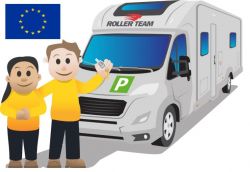
It's your first trip out in the EU
Traverling around the EU?
EU roads
EU driving
- The primary distinction between driving in the EU and driving in the UK boils down to which side of the road you're on. Nevertheless, embarking on a motorhome journey within the EU can be an exhilarating adventure, often considered the most gratifying aspect of ownership.
- One notable advantage is the broader roads that await you. Many of the finest destinations are conveniently accessible and even offer designated motorhome parking areas
-
Toll Roads: When traveling in Europe, you'll encounter tolls in eight EU countries. These countries are France, Greece, Ireland, Italy, Croatia, Poland, Portugal, and Spain. Tolls are fees you pay for using specific routes. They're calculated based on the distance you travel.
While toll roads can be a bit of an expense, they offer some fantastic benefits. For starters, they often mean smoother and faster journeys on well-maintained roads. And guess what? Along these routes, you'll find these cool spots called Aires. These are like pit stops tailored for travelers like you. You can take a break, stretch your legs, and enjoy good amenities.
But of course, it's worth keeping in mind that tolls can add up, potentially eating into your holiday budget. The trade-off between the convenience and road quality they provide and the cost they come with is something to consider as you plan your adventure. So, as you hit the road, just remember to factor in these toll expenses while enjoying the perks they offer!
-
When it's time for a quick stop at the supermarket for essentials, parking restrictions are often less stringent. And while accessing town centers might pose a challenge at times, a solution often lies in parking just beyond the center at one of the aforementioned spots. Using bikes to navigate the remaining distance becomes a remarkably easy alternative.
- In terms of driving licenses, a typical motorhome falls into Category B. This means that if you hold a Category B license, you're authorized to drive motorhomes with maximum weights of up to 3,500kg.
- Many countries classify motorhomes under the 3.5t weight threshold in a manner akin to cars. Consequently, they adhere to the same speed limits as cars on roads. However, it's imperative to bear in mind that regulations can fluctuate from one country to another, and even within different regions of the same country.
Please Note
To ensure accurate and current information pertaining to motorhome classifications and speed limits in a specific country, consulting the official government transportation or road safety agency is your best course of action. These agencies maintain the most up-to-date and precise data regarding motorhome categorizations, speed limits, and any other pertinent regulations.
Navigating around the EU
EU relationship with Motorhomes
Owning a motorhome opens up an incredible avenue for discovering the enchantments of the EU.
- When it comes to cruising through the EU with your trusty SatNav, you'll want to make sure your maps are up to date – unless, of course, it already includes EU navigation. Remember, you're bidding farewell to postal codes and might find yourself relying more on GPS coordinates for precise navigation.
- For embarking on truly scenic adventures, think about adding a bicycle to your motorhome journey. This little addition offers you unparalleled freedom to explore your surroundings.
- Restocking your supplies is a breeze, and many local supermarkets generously offer wide and lengthy parking spots to make your shopping pit stops hassle-free.
- The charm of cycling is spreading across most European destinations. Utilizing bicycles not only eases your entry into city centers, but also contributes positively to the environment.
- You'll notice that motorhomes are a familiar sight in the EU, leading to standardized provisions by local councils for motorhome travelers.
- So, with your motorhome in tow, you're all set to discover the abundant beauty and warmth the EU has to offer.
A-Frames
Every country has its own traffic and driving regulations, it’s always best to know these as best you can before you set off.
If you are towing a car behind a motor caravan overseas, our advice would be to use a trailer with all four wheels of the car off the ground. Although most countries do not have a specific law banning A-frames, they do have a law which prohibits a motor vehicle towing another motor vehicle.
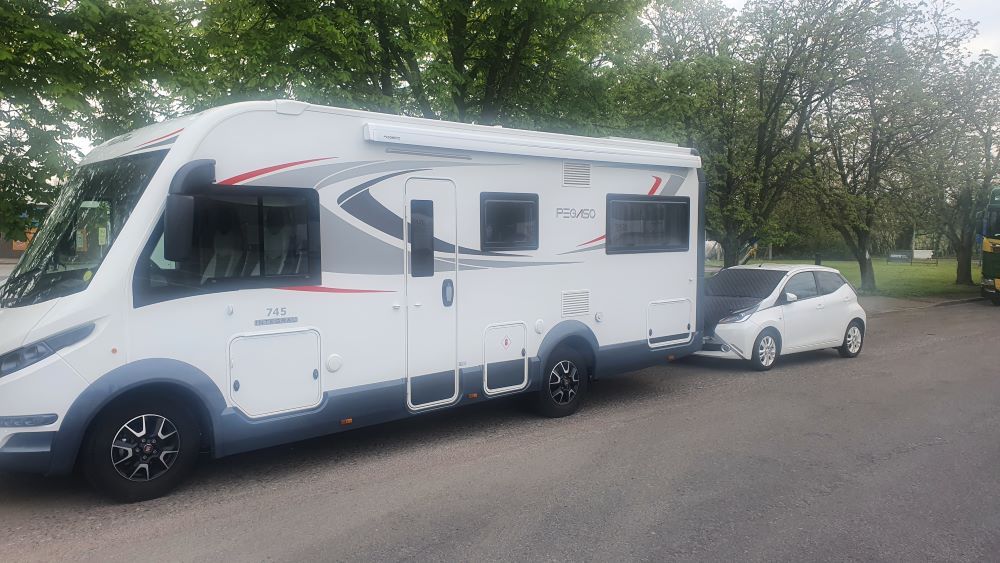
Bike Racks
You can carry your bikes on the roof of your car provided they are attached to an adequate roof-rack and the total height does not exceed 4m.
You can also carry your bikes on the back of your vehicle, provided they do not obscure lights, indicators or number plates. If travelling through Portugal, make sure your bikes are carried at the rear of your caravan or motorhome and not your car.
Bike racks can only rest on the towbar if the maximum weight on the towbar is not exceeded.
Reflective board
The image demonstrates the proper way to position marker boards on a cycle carrier, contingent on whether the overhanging load surpasses the vehicle's width. When the load remains within the vehicle's width, the marker board should be affixed perpendicularly to the lighting board. However, if the load exceeds the vehicle's width, two hatched reflective stripes are required, one on each side, forming an inverted V shape.
For travel in both Spain and Italy, it's imperative to have both a lighting board and a marker board. In the case of the rear marker board in Spain, the design comprises 3 red and 3 white hatched, reflective stripes. Meanwhile, in Italy, the design calls for 5 red and 4 white hatched, reflective stripes.
Furthermore, in compliance with regulations in Spain and Italy, any overhanging loads must be clearly indicated by a square panel measuring 50cm x 50cm. This square panel must feature diagonal stripes in red and white that are reflective for enhanced visibility and safety.
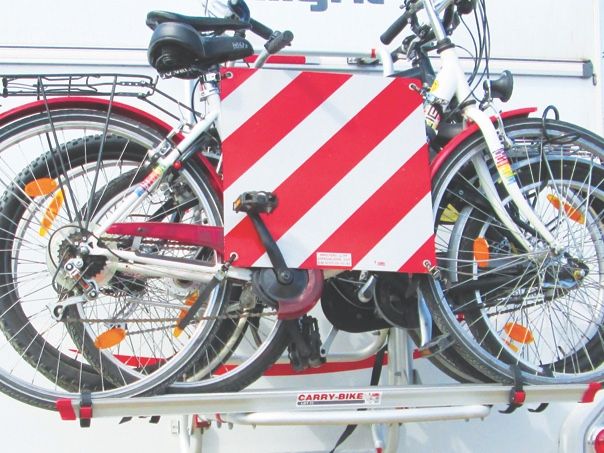
Number plates - UK Identification
It is a requirement to prominently display a United Kingdom (UK) identifier on the rear of your vehicle when operating it in European territories. However, there are specific conditions regarding the need for a separate UK sticker:
1. If your vehicle's number plate includes the standalone "UK" designation or features "UK" alongside the Union flag, then you do not require a distinct UK sticker. This exemption applies across most European countries, except for Spain.
2. In the case of travel to Spain, a separate UK sticker is obligatory, even if your number plate already includes "UK" or "UK" with the Union flag.
3. A separate UK sticker is mandatory on the rear of your vehicle under the following circumstances:
- If your number plate displays a Euro symbol.
- If your number plate showcases a national flag of England, Scotland, or Wales.
- If your number plate lacks any flag or identifier related to the United Kingdom.
Compliance with these stipulations is essential to ensure that your vehicle adheres to the legal requirements for displaying a UK identifier while traveling in European countries.
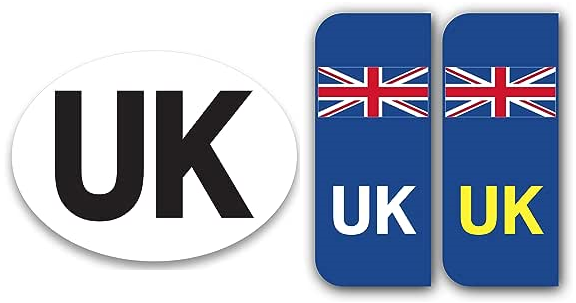
Regulations for Outfits Exceeding 12m in Length:
When traveling in Spain and your outfit surpasses a length of 12 meters, it is a mandatory requirement to affix marker boards to the rear of your vehicle. You have the option of using either two smaller boards or a single larger board, but these must be positioned at the rear of the outfit and be situated between 50cm and 150cm above the ground.
Key specifications for your marker board include:
- The board should feature a central section in plain yellow with a red outline.
- It must be constructed from aluminum material.
- The manufacturing should adhere to the ECE70 standard.
You can procure marker boards from numerous HGV suppliers, including HGV Direct.
Additionally, in compliance with Article 3 of EU Directive 96/53/CE, if you plan to use caravans and camper vans registered in another EU country in Italy, they must not exceed the following dimensions: a length of 12 meters, a height of 4 meters, and a width of 2.55 meters.
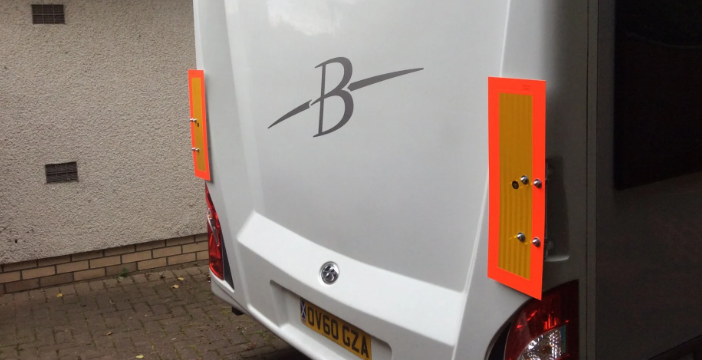
Regulations for Vehicles Exceeding 3,500kg in France:
Effective as of January 1, 2021, all motorhomes and caravans (when not in combination with a towing vehicle) exceeding a total weight of 3.5 tonnes are mandated to display a sticker indicating the location of blind spots. These stickers are required to be visible from both the sides and the rear of the vehicle, positioned within the height range of 0.90 to 1.50 meters above the ground.
Key stipulations for these stickers include:
-
Visibility: They must remain visible from the sides and rear of the vehicle at all times.
-
Attachment: Stickers can be adhered to the bodywork, painted on, affixed by riveting, or secured using any other approved method.
-
Unobstructed Visibility: These stickers must not obstruct the visibility of the vehicle's registration plates, various lights, signaling devices, or impede the driver's field of vision.
-
Compliance: The stickers must adhere to the model specified in the January 5, 2021, decree.
It's important to note that foreign vehicles transiting through France are also subject to these signage requirements.
Note: There are no specific blind spot stickers for motorhomes or caravans
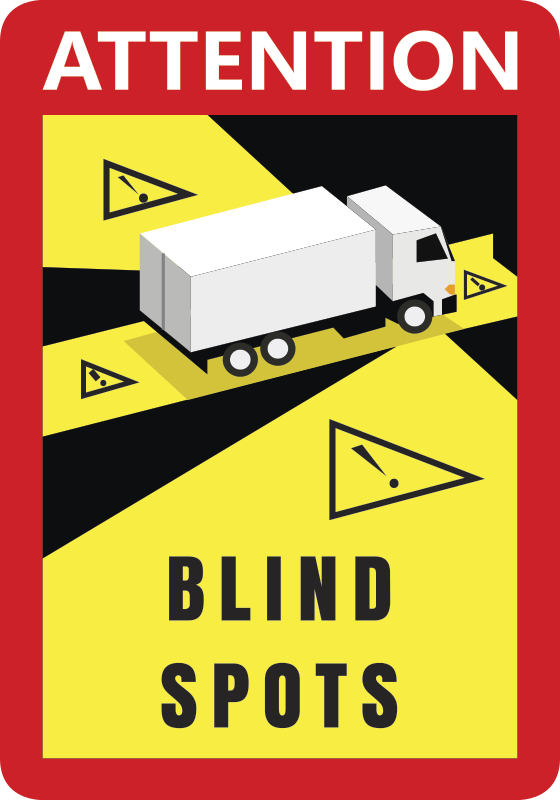
Low emission zones - stickers
Low Emission Zones (LEZs) in the European Union (EU) and the requirement to display clean air stickers can be summarized as follows:
Purpose of LEZs: LEZs are established in EU cities and regions to improve air quality and reduce pollution by restricting or regulating the entry of vehicles based on their emissions.
Emission Standards: LEZs define specific emission standards that vehicles must meet to enter the zone. These standards are often based on European emission classifications like Euro standards.
Clean Air Stickers: Many LEZs require vehicles to display clean air stickers or emissions badges to indicate their compliance with emission standards. Stickers are color-coded or numbered to signify different levels of compliance.
Sticker Categories: The categories and colors of clean air stickers can vary among member states and cities, so it's important to understand the local classification system.
Application and Registration: Vehicle owners typically need to apply for clean air stickers through local authorities or online platforms. This may involve providing emission-related documentation and paying a fee.
Enforcement: LEZ compliance is enforced using methods like automated cameras that scan stickers or license plates. Non-compliant vehicles may face fines or penalties.
Exemptions: Some vehicles, such as electric cars or certain types of vehicles used for specific purposes, may be exempt from LEZ restrictions or clean air sticker requirements.
Temporary Access: Some LEZs offer temporary access permits for non-compliant vehicles, often for a fee and a limited duration.
Public Awareness: LEZ authorities inform the public about regulations, sticker requirements, and boundaries through public awareness campaigns, websites, and signage.
Cross-Border Travel: Travelers should be aware that LEZ regulations and clean air sticker requirements may vary between EU countries and cities, necessitating research and compliance with local rules.
Compliance with LEZ regulations and displaying the correct clean air sticker, if required, is essential to avoid fines and access issues when traveling within the EU.
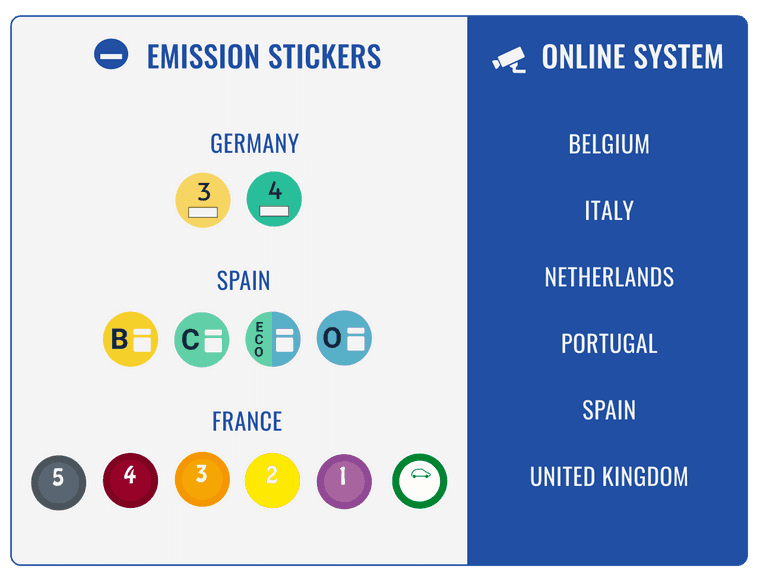
| Country | First Aid Kit | High Visibility Vest | Warning Triangle | Daytime Lights |
|---|---|---|---|---|
| Austria | Yes | Yes | Yes | Yes |
| Belgium | No | Yes | Yes | No |
| Croatia | Yes | Yes | Yes (2 if towing) | Yes (during winter months) |
| Czech Republic | No | No | Yes | Yes |
| Denmark | Rec | Rec | No | No |
| France | No | Yes | Yes | Rec |
| Germany | No | No | No | No |
| Hungary | Yes | Yes | Yes | Yes |
| Ireland | No | No | No | No |
| Italy | No | Yes | Yes | Yes |
| Luxembourg | No | Yes | Yes | Rec |
| Netherlands | No | No | Rec | No |
| Norway | Rec | Rec | Yes | Yes |
| Portugal | No | Rec | Yes | No |
| Slovenia | Rec | Yes | Yes (2 if towing) | Yes |
| Spain | No | Yes | Yes (2 if towing) | No |
| Sweden | Rec | No | Rec | Yes |
| Switzlerland | No | No | Yes | Yes |
-
Breathalyzers in France
If travelling through France, make sure you have a breathalyser to hand. Although it is not a legal requirement anymore we still advise you carry one. Make sure your breathalyser is NF approved.
-
Sat-navs and dash cams
The regulations concerning the use of car navigation systems, dash cams, and speed camera warnings in European countries are as follows:
Car Navigation Systems and Speed Camera Warnings:
- Car navigation systems that actively seek out mobile speed cameras or interfere with police equipment (e.g., laser or radar detection) are illegal in nearly all European countries.
- Car navigation systems providing warnings about fixed speed camera locations are generally legal in most countries, except for France, Germany, and Switzerland, where this function must be disabled.
Dash Cams:
-
Several EU countries have restrictions on the use of dash cams, and violations can result in substantial fines.
-
In Austria and Portugal, both owning and using a dash cam are illegal, with potential fines reaching as high as €25,000. Luxembourg also prohibits dash cam usage.
-
In Belgium, France, Germany, Norway, and Switzerland, dash cams are legal, but there are stringent usage conditions. It is advisable to check the specific requirements before using one.
-
Denmark, Italy, the Netherlands, Spain, and Sweden allow the ownership and unrestricted use of dash cams.
It's important for travelers to be aware of and adhere to the laws and regulations regarding car navigation systems and dash cams in the specific European country they are visiting to avoid legal issues and potential fines.
-
Headlights
Headlight adaptors, also known as headlight converters or beam deflectors, are necessary when driving a right-hand-drive (RHD) vehicle in countries where traffic drives on the right-hand side of the road (left-hand traffic or LHT) and vice versa. The primary purpose of headlight adaptors is to prevent your vehicle's headlights from dazzling oncoming drivers when you're driving in a country with opposite traffic rules. Here's why you need headlight adaptors:
Preventing Headlight Dazzle:
In a RHD vehicle, the headlights are designed and adjusted for driving on the left side of the road. When you drive in a country where you need to switch to the right side of the road, your headlights can project their beam directly into the eyes of oncoming drivers, causing glare and reducing road safety.
Legal Requirement:
Many countries have strict regulations regarding headlight usage to ensure the safety of all road users. Using headlight adaptors helps you comply with these regulations, preventing potential fines and penalties.
Safety:
Dazzling oncoming drivers can create hazardous driving conditions, impairing their ability to see the road clearly. Headlight adaptors mitigate this risk, enhancing overall road safety for both you and other drivers.
Avoiding Accidents:
Preventing glare from your headlights reduces the likelihood of accidents caused by temporary loss of visibility or confusion among other road users.
Legal Liability:
If you are involved in an accident that can be attributed to improper headlight adjustment or dazzling of other drivers, you may face legal liability and potential insurance issues.
Headlight adaptors work by redirecting the beam pattern of your vehicle's headlights so that it is appropriate for the side of the road you are driving on. They are typically adhesive or magnetic attachments that you place on your headlights, covering a specific portion of the beam to prevent glare.
It's essential to check the specific headlight regulations and requirements of the country you plan to visit, as headlight adaptor specifications and usage guidelines can vary. By using headlight adaptors when necessary, you ensure road safety, compliance with the law, and a smoother driving experience when traveling internationally.
-
Fire extinguishers
Fire extinguishers are not compulsory but are recommended in the Netherlands, Denmark, Norway and Sweden.
What will I need?
-
Your Motorhome Garage
Getting it ready
- When getting your motorhome ready for your journey, keeping track of its weight is crucial. It's a good idea to adopt a simpler approach while still holding onto the essentials.
Your Tavel plans
Your travel plans will be shaped by factors like weather conditions and the type of vacation you're aiming for. For example, if you're thinking of tackling the stunning Ben Nevis for its incredible vistas, the items you'll need will differ quite a bit from what's required for a relaxed beach getaway.
Rundown
Here's a rundown of items to consider for your motorhome adventure:
- Basic Toolkit: No need to lug around an entire mechanic's toolbox. Usually, if something beyond simple screw tightening is needed, you can contact a garage or your breakdown service. A versatile multi-toolkit should suffice.
- Outdoor Folding Seats: These seats come in various levels of comfort and collapsibility. They'll be a real treat during your travels. Remember, though, that taking different seat styles occupies precious space.
- Ground Sheet: A breathable awning groundsheet protects your feet and keeps the inside cleaner. It's especially helpful after outdoor activities.
- Small Folding Table: Perfect for those warm evenings when you just want to relax outdoors.
- EHU Cable: Around 25 meters long, this cable is slightly different from a regular extension cable. It's made of higher-quality material and has a load capacity greater than 16 amps. It's equipped with a CEE 17 plug at one end and a female connector at the other, specifically tailored for motorhome use.
- Levelling Chocks: These wedge-shaped ramps help level your motorhome, ensuring appliances like the fridge work properly. Plus, they eliminate the feeling of being off-kilter inside.
- Collapsible Bucket: You'd be surprised at how many tasks a bucket can tackle. It's a versatile tool for various needs.
- Hosepipe and Fittings: Around 10-15 meters in length, this hose should feature a universal hose connector (hoselock type) and a fitting that goes into your motorhome's water storage tank. Having a screw-type converter on hand is also wise.
- Bungee Straps: These versatile straps have countless uses, from securing items to holding things down.
- Gas Bottle Spanner: Needed for attaching or detaching the gas bottle hose. Some hoses might have hand-screw attachments, so check yours.
- Tent Pegs or Ground Pegs: In case the wind picks up, these are handy for securing your groundsheet and furniture.
- Awnings: If you have an awning, make sure to carry awning straps. This will help prevent damage caused by unexpected winds.
- Gas Bottle: If your motorhome doesn't have one already, having a gas bottle is crucial for cooking and heating.
- Mud Mats: These come in handy if it gets wet. Placed under the driving wheels, they provide traction in slippery conditions.
- Tow Eye Screw: This threaded bar with a ring is a lifesaver if you get stuck. It allows you to attach a tow rope without damaging your motorhome's suspension arm.
Remember
Remember, this list can be customized based on your specific trip. It's always a good idea to take a short trial vacation close to home to iron out any kinks before embarking on a longer journey. You'll be amazed at what you can learn from this experience.
-
At the ferry or tunnel
The first time you embark on your motorhome adventure, it may initially feel a bit daunting. Whether you're heading to the ferry or the tunnel, the uncertainty of where to go and what to do can be overwhelming.
The best advice is to plan to arrive with plenty of time to spare. It's always preferable to be early, affording you the luxury of savoring an extra cup of tea rather than scrambling to meet a tight deadline. Beginning your holiday with a relaxed pace can make those additional hours truly worthwhile.
Upon arrival, keep an eye out for signage. If you're fortunate, you may find it easy to follow the path set by fellow motorhome enthusiasts. Most importantly, don't hesitate to seek assistance or ask for directions if needed.
If you're traveling with your furry companion, you'll typically need to check them in first. You'll then receive a designated boarding time and number. These details will be displayed on electronic boarding screens, guiding you on when to proceed to the terminal or boarding queue.
Keep your booking reference number handy
- You'll need to show this to the staff at your crossing. If you’ve booked your crossing with the Caravan and Motorhome Club, you’ll receive an email confirmation including your number
Follow the signs for the ferry operator
- you’ve booked with when you arrive at the ferry port, then show the staff your reference number and they’ll check you in and tell you which lane to queue in.
If you book with Eurotunnel directly, you can use their self-check-in lane.
- All you need to do is enter your reference number at the kiosk and follow the instructions on the screen.
-
Before you arrive on site
-
Receptions often close at lunch times, so try to plan your arrival either side of this.
-
Some campsites don’t allow long swimming shorts in the pool – best to pack your brief-style trunks.
-
Bring some extra toilet roll or put it on your shopping list for when you arrive, as some campsites don’t supply it.
-
You might need to put down a deposit for a key, as some campsites have entry/exit barriers to the site.
-
-
At the campsite
- Try to keep cash on you as some campsites don’t accept cards.
- Some sites have separate parking and don’t like you to park your car on your pitch, check with reception where you should park your car.
- Some campsites have electricity that’s metered – check with reception on arrival.
- Some campsites don’t allow traffic movement between the hours of 11pm and 8am, so if you need to arrive really late or leave extra early, have a chat with the campsite first.
- Some sites may want to see your passport
- It is often the case that they need to also charge a small tax on top of your agreed fees. This is normally a small percentage
- Depending how busy the site is will determine how flexible they are around moving or changing the allocated pitch. Most will try to help if you have any specific requirements, but please be respectful that often this is not straight forward
-
Essential Living Accessories
Making Your Rolling Home Feel Just Like Home
-
Entertainment on the Go:
While you're out and about exploring, it's good to be prepared for those occasional rainy days. That's where a TV can swoop in as your rainy day hero. But here's the catch: aim for a TV that's tailor-made for your motorhome and can run on 12 volts. This kind is perfect for when you're off the grid, soaking up nature's beauty.
However, there's a little twist when it comes to watching TV outside the UK. Your UK coverage won't stretch that far, unfortunately. So, if catching your favorite shows is on your list, you'll need to plan ahead. Many fellow motorhome adventurers opt for a satellite system. It's like bringing your local TV with you wherever you roam. But keep in mind, the farther you wander, the trickier satellite signal access might get.
Now, here's the tech-savvy scoop: some folks are turning to mobile data for their TV fix. They're creating a nifty setup where their TV is linked to their mobile data. They use apps to stream TV content. It's modern and convenient, but there's a data gobbling monster lurking. Streaming can chew through data pretty fast – about a gigabyte per hour if you're watching in standard definition. So, while it's a cool option, just make sure you're aware of the data feast it can create.
So, whether you're cozying up for a movie marathon or catching up on the latest episodes, having your entertainment options sorted can make your motorhome adventures even more enjoyable!
- Snuggle-Worthy Bedding
Your bed should be a haven. Keep it simple with a duvet, sheet, and pillows. Adding a mattress topper can take your sleeping game up a notch. - A Cleaning Crusade
Staying sane on the road means keeping things tidy. A rechargeable handheld vacuum will be your cleanliness sidekick. - Cleaning Magic with Minimalism
You don't need a ton of cleaning products. Everyday stuff like dish soap, lemon, and white vinegar can work wonders. - Plates of Wonder
Consider 'Melamine' plates – they're practically indestructible and super light, making dining a breeze. - Cutlery Counts
Pack enough cutlery for your crew, plus a couple of extras. No need to prepare a feast; simple and practical wins the day. - The Toilet Chronicles
Don't skimp on the TP, but opt for the lighter stuff to avoid plumbing mishaps. And yes, there's a rainbow of toilet chemicals, each with its superpowers. - Towels Galore
Keep yourself dry, your face fresh, and your dishes clean with a stash of towels and cloths. - Kitchen Essentials
Dishcloths, scourers, and a trusty bowl for dish hauling – these are your kitchen buddies. And let's not forget, the BBQ often steps up as the kitchen extension! - Privacy Matters
Those external screen blinds are lifesavers. They keep the temperature comfy and give you a private haven at night. - Tools of the Trade
Equip yourself with the basics: tin and bottle openers, cheese graters, sharp knives, and even a corkscrew for those special evenings. - The Mighty Kitchen Kettle
Can't do without that cuppa, right? A trusty kettle is essential for your gas hob adventures.
-
-
Driving Accessories
Driving your motorhome might seem a bit intimidating at first, but with a few handy additions, it can actually turn into a more enjoyable experience than your typical daily commute.
- A SatNav, especially one tailored for motorhomes, can be your guiding light to a stress-free journey. It's like having your very own travel angel ensuring you arrive at your destination hassle-free. And just in case your SatNav decides to act up, having a trusty UK Road Atlas as a backup can be a lifesaver. Also not that in many EU coun tries having speed camera alerts is illigal and you may need to turn these off, also don't forget to change the settings from Miles to Km, it does help to avoid accidental speeding.
- Ever bumped your wing mirror and felt a sting in your wallet? Mirror Protectors are a lifesaver, especially while you're still getting the hang of maneuvering your new motorhome. Investing in these can save you from shelling out for a replacement mirror, which can cost over £100.
- A hands-free phone device is a must, doubling up as a mobile phone holder. This little addition can keep your attention on the road while ensuring you're always within reach.
- Don't forget creature comforts! A drinks holder can make those scenic stops even more enjoyable. And speaking of capturing the scenery, a Dash Cam might not always be necessary, but it's good to have just in case. There are times when other drivers can get a bit impatient, and having video evidence can be a saving grace.
- Safety first, always. A well-stocked First Aid Kit is a no-brainer. Hopefully, you'll never need it, but it's always better to be prepared.
- Now, breakdowns happen to the best of us. So, having breakdown cover for your motorhome is a smart move. If you're planning to venture into the EU at any point, make sure to include this coverage when you make your purchase. It's often trickier to add it on later.
- Toll Tags - You can either pay at the barrier every time you approach one, which will probably involve some queuing, or you can buy a “Toll Tag” which automatically allows you through the barrier without having to physically stop and pay and then it charges your account.
- Remember, with the right gear and a positive outlook, driving your motorhome can turn into a wonderful adventure every time you hit the road.
-
Additional items for the EU
When driving in the EU it is common in most EU countries to have with you at all times the following.
(Please check with the visiting country - and any countries you may pass through)
- UK driving license. You need to take your UK driving license with you when you drive in Europe.
- International driving permit if required, in most cases it's not (IDP)
- Certificate of motor insurance.
- Vehicle registration documents.
- UK car sticker (if you don’t have a GB Euro number plate, or no matter what's on you number plate when driving in Cyprus, Malta or Spain)
- European breakdown cover.
- Reflective jackets (there must be one for each passenger and be kept within the cabin of the car)
- Warning triangles.
- Crit’air sticker if driving in France
- Headlamp beam deflectors (depending on your car, you’ll either need deflector stickers or have to adjust the beam manually)
- First aid kit (compulsory in Austria, France and Germany)
- Proof of ID (passport)
Other items you may find useful
- Country plug adapters
- EU phone and data contract
- Some local currency kept for emergency.
- a list of emergency numbers - police - doctors - fire - ambulance
- Credit card - debit card
-
Taking your pet with you?
- If you're considering bringing your furry friend to an EU Country post-January 1st, 2021, there's crucial information to ensure your travel plans go smoothly for both you and your pet.
- Pre-Travel Preparations: Before embarking on your journey, especially with your dog, cat, or ferret, you'll want to begin these steps at least four months ahead of your intended travel date:
- Microchip: Ensure your pet is microchipped, a necessary identification measure.
- Rabies Vaccination: Your pet needs to be vaccinated against rabies. Note that your pet must be at least 12 weeks old before receiving this vaccination.
- Blood Sample: Following the primary rabies vaccination, arrange for a blood sample to be taken at least 30 days later. This sample will be sent to an EU-approved blood testing laboratory.
- Waiting Period: After the successful blood sample, there's a mandatory three-month waiting period before your pet can travel.
- Animal Health Certificate (AHC): Once your pet's blood sample is cleared, your vet will provide you with a copy of the test results and create an Animal Health Certificate (AHC) that includes the day the blood sample was collected.
- Travel Restrictions: Your pet can only travel if you possess a valid Animal Health Certificate. Unfortunately, without it, your pet won't be allowed to accompany you.
- Unsuccessful Blood Test Result:
- If your pet's blood test doesn't meet the requirements, a re-vaccination and another blood test after an additional 30-day wait will be necessary.
- Future Travels to the EU:
- As long as your pet's rabies vaccinations are kept current, you won't need to redo blood tests for subsequent trips to the EU. However, every time you travel, make sure to obtain an Animal Health Certificate (AHC) from your vet within 10 days before departure.
By adhering to these guidelines, you can ensure a safe and enjoyable journey for your pet within the EU.
The following information as a general guideline. It's highly advisable to consult with your veterinarian at the earliest opportunity since these requirements and regulations are subject to change. Your vet will provide you with the most up-to-date and accurate information tailored to your specific situation. Your pet's health and well-being are of utmost importance, and your vet's guidance will ensure a smooth and safe travel experience.
-
Returning with your Pet?
- Bringing your dog back to the UK from EU country involves adhering to the Pet Travel Scheme (PETS) rules. Please note that regulations might have changed since writing this, so I recommend verifying the most current requirements with the official government sources or a veterinarian. As of September 2021, the following general guidelines apply:
- Microchip: Your dog must be microchipped with an ISO 11784/11785 compliant 15-digit pet microchip. This microchip ensures proper identification.
- Rabies Vaccination: Your dog needs a valid rabies vaccination. Ensure the vaccination is administered after the microchip has been implanted. Your pet should be at least 12 weeks old before getting vaccinated.
- Pet Passport or Health Certificate: Your dog will need an EU pet passport issued by an official veterinarian or an official third-country health certificate. This document confirms that your dog has been microchipped, vaccinated against rabies, and is in good health.
- Tapeworm Treatment: If you're traveling to the UK from a listed tapeworm-free country (which includes most EU countries), your dog will need to be treated against tapeworm using an approved product 24 to 120 hours before arriving in the UK.
- Blood Test (if applicable): If your dog is traveling from an "unlisted" country, it may need a blood test to demonstrate sufficient rabies antibody levels. The blood test must be taken at least 30 days after the rabies vaccination.
- A Wait Period: There's a minimum 21-day waiting period from the date of the successful rabies vaccination or blood test (if applicable) before traveling to the UK.
- Approved Route: Your dog must travel into the UK on an approved route and with an approved transport company.
Keep in mind that regulations can change, and the timing and specifics of treatments may vary. Additionally, the UK's rules for pet travel might differ after the transition period following Brexit.
Always consult the official UK government website or your veterinarian for the most accurate and up-to-date information before you plan your journey.
The following information as a general guideline. It's highly advisable to consult with your veterinarian at the earliest opportunity since these requirements and regulations are subject to change. Your vet will provide you with the most up-to-date and accurate information tailored to your specific situation. Your pet's health and well-being are of utmost importance, and your vet's guidance will ensure a smooth and safe travel experience.


